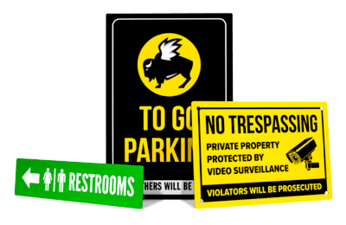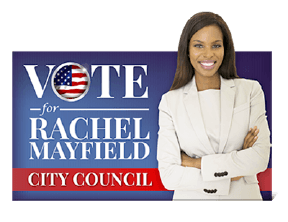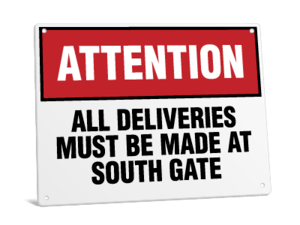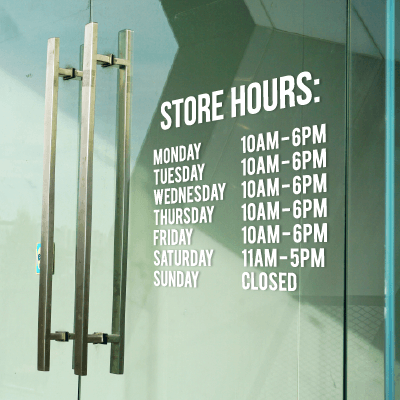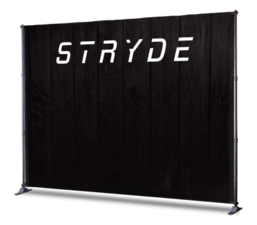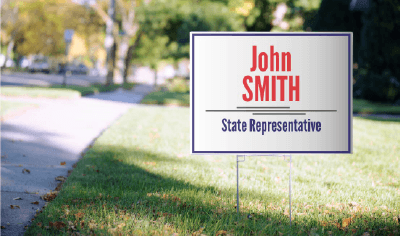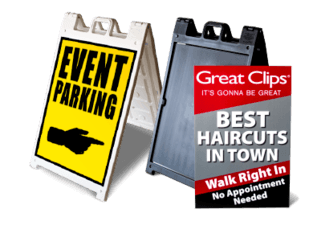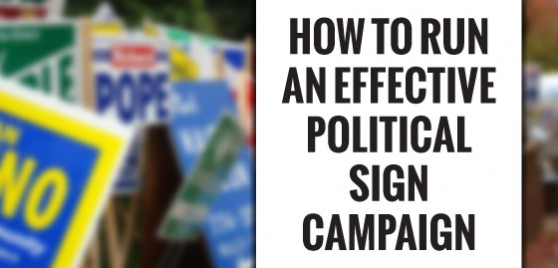As this year’s national elections approach, you can expect to see more yards and lawns decked with political campaign signs– that is, if you haven’t yet. As soon as the campaign period rolls in, campaign strategists and supporters design and print political signs to push their candidate’s agenda or to promote their advocacy. But inquiring minds (not to mention political candidates, campaign strategists, and voters) want to know: do political yard signs really work? Do they convert casual sign observers into bona fide voters? In this article, we explain what exactly political signs do and don’t do. Overall, we make the case that whether you’re running for school board or the Senate, campaign signs will be a valuable part of your overall election strategy.
When Political Signs Work: The Advantages of Using Political Campaign Signs
- They increase a candidate’s name recognition.
In politics, recognition is the name of the game. As prominent political scientist David Mayhew once said, “To be perceived at all is to be perceived favorably.” One of the main tasks for any political candidate is to ensure that their name becomes familiar to the prospective voters. An effective way to increase political visibility is to display many campaign signs, and there is scientific evidence supporting this strategy.
In the “Ben Griffin” experiment, Vanderbilt University professor Cindy Kam planted campaign signs for fictitious candidate Ben Griffin in high traffic areas around a school. A few days later, they conducted a survey via the school’s Parent Teacher Association asking participants to list their preferred council candidates — the fictitious Ben Griffin was listed along with real candidates and another made-up person. All to say, the consistent exposure to campaign signs established name recognition among the participants and influenced them to vote for the person whose name appeared on the said sign. - They encourage people to participate.
Another way that political signs can improve a candidate’s electoral prospects is by reminding supporters to vote. Although signs are unlikely to change a voter’s mind about a particular candidate, they may help remind people who already like the politician to vote on Election Day if used strategically.
Political scientist Costa Panagopoulos tested whether campaign signs would actually increase voter turnout by studying the 2005 municipal elections in New York City. After identifying 14 election districts whose historical voter turnout was nearly identical, Panagopoulos strategically stationed sign-toting volunteers at busy intersections in seven randomly selected districts with large white signs that stated “Vote Tomorrow” in blue letters.
In the actual election, the voter turnout in the seven districts where volunteers held signs (the “treatment” group) was 3.6% higher than the turnout in the districts where signs were not displayed (the “control” group). While this difference may seem trivial, a 3% increase in the vote percentage can have a huge impact on a close election. Moreover, this increase in turnout seems to be comparable to the results of other “get out the vote” techniques such as door-to-door contacting, phone calls, and direct mail, which often require significantly more resources (time, money, and manpower) than does signage.
As the research summarized above illustrates, campaign signage can have a meaningful effect on voter turnout. Candidates who use signs strategically may be able to target the people who are inclined to vote for them, perhaps by placing signs in areas where supporters are highly concentrated. - They influence social cues and people’s opinions.
Classic studies in political science (see, for example, Voting by Berelson, Lazarsfeld, and McPhee, 1954) have found that a person’s family, friends, neighbors, and coworkers can have a strong impact on who they vote for. Political signage may help reinforce these powerful social forces by serving as voting cues. In other words, signs can spread political information between two people even if a political discussion never takes place.
Take this for example. Imagine that two neighbors, Tim and Wilson, are good friends who talk about most everything — except politics. When Wilson places a political sign in his yard for Jill Taylor, a local school board candidate, Tim notices the sign on his way to and from work but doesn’t think much about it. When the election arrives, Tim goes to the polls to vote for a friend running for city council. After voting for his friend, Tim comes to the portion of the ballot that asks about the school board vote. Although he is not familiar with any of the candidates, Tim remembers that his friend Wilson supports Jill Taylor. While his personal knowledge is limited, Tim knows that he trusts Wilson, so he votes for Jill.
Just as in this scenario, voters use “information shortcuts” to make ballot decisions all the time. While campaign signs may not inspire instant confidence in a candidate per se, they can help uninformed voters connect a candidate’s name to friends or family members that they trust. In this way, candidates can use signage to tap personal networks that are powerful sources of vote motivation. - They mobilize participation among candidates and supporters.
Campaign signs can also provide supporters with a way to express themselves politically, allowing them to voice their opinions and feel connected to a candidate. Political scientists Todd Makse and Anand Sokhey argue that “Yard signs constitute an important, symbolic aspect of what we might call an ordinary individual’s “total campaign experience.” In other words, posting signs can be a form of political participation in and of itself.
Signs can also provide campaign volunteers with a way to openly show their friends and neighbors the candidate that they support. In a way, signs can function as a symbol of the volunteer’s hours of hard work for the campaign. Moreover, sign drives give campaign faithful the opportunity to have tangible evidence of their dedication to the cause; whenever they see a sign-lined street, they will feel they have accomplished something important. Candidates who want their supporters to feel they are truly involved in the campaign and are able to fully express their political voices should incorporate political signs into their overall election strategy. As Maske and Sokhey observe, “Campaign professionals may debate the power of yard signs as a mobilization tool, but . . . these signs are anything but trivial to the individuals who display them.” - They strengthen a candidate’s local visibility.
Ironically, campaign signs tend to be used most when they are least effective — presidential elections. Since presidential races are extremely visible to the public eye, nearly everyone who is going to vote has relatively defined opinions about the candidates involved. Because of this, campaign signs are unlikely to have a major impact. As behavioral psychologist Mark Sibicky notes in a recent interview, “Signs do little to change anyone’s mind that is already made up.” At the same time, signs can be important for elections where candidates are relatively unknown. Candidates for municipal offices such as school board, sheriff, city council, mayor, and judgeships are often relatively unknown, so the added name recognition generated by political signage is invaluable.
Additionally, because municipal offices in many localities omit partisan labels from the ballot, voters who are unable to decide based solely on the political party may turn to the candidates whose names they are most familiar with. Politicians running for lesser-known state offices such as state auditor, treasurer, and even attorney general can also benefit from the increased notoriety that signs provide. - They’re affordable and easy to set up.
The technology to design and produce campaign signs has grown directly proportional to the demands of election season. As digital printing gets better every day, it’s become easier and faster to create plenty of signs in a short amount of time. The variety of signs has expanded too — from the classic yard sign that you can easily stick to the ground, printing companies now offer an assortment of banners (vinyl, fabric, and mesh), car decals, stickers, magnets, and foam board signs — and they come with different easy setup options. These sign types have also become relatively easy to create, with printers offering online design tools and free sign templates customers can use, making it more accessible to supporters regardless of design skill level. Above all, campaign signs are an affordable means of showing support whether it’s a candidate you’re campaigning for or you’re a part of an organization that pushes the advocacy of voting.
When Political Signs Don’t Work: The Limitations of Political Campaign Signs
- It can be difficult to measure its success.
Putting up signs in your lawn is one thing, but unless you go to the polling precinct and actually vote, it can be hard to tell whether the political sign is successful at bringing the votes in. Indeed, some studies show that signs may simply be an indicator of existing support rather than a tool for converting voters from one candidate to another. Another possibility is that voters are simply more expressive than other people. One study suggests that whether a person displays a sign for the local university football team predicts voting just as well as whether they display a political sign. - Quantity doesn’t always mean quality.
It’s not uncommon for well-funded political campaigns to deploy plenty of signages throughout the election period. However, campaign signs are unlikely to be the main factor determining how a person will vote. In other words, deep-pocketed candidates who pepper their districts with signs will not necessarily win an election unless their campaign message aligns with constituent priorities. Things like political party, ideology, education, family influence, and personal contact with candidates are much more likely to affect vote choice.
Are campaign signs a sure-fire way to convert a disinterested or opposing citizen into a legitimate supporter? Probably not. Even though signs may not be the most important factor influencing individual voting decisions, they can still have a powerful effect on a candidate’s political fate. In close races (especially those that are not salient to the voting public), signs can have a profound impact on election outcomes.



